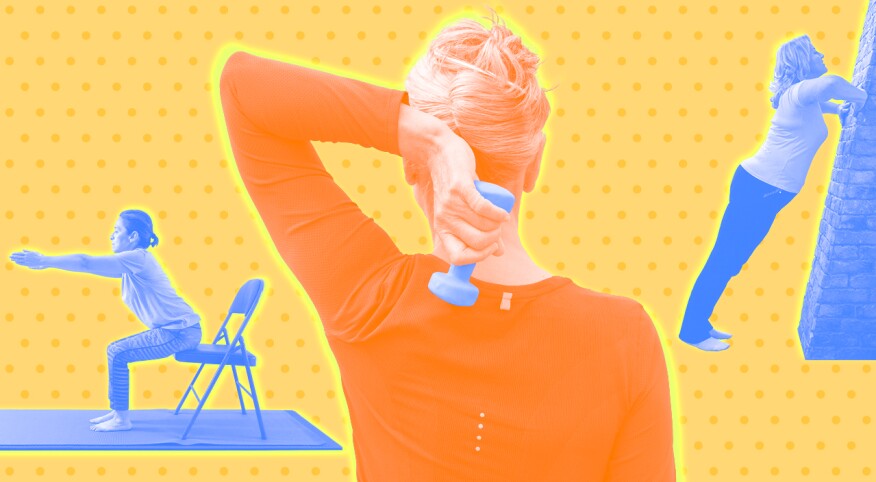When exercise instructor Cheryl Seabright, 55, of Millersburg, Ohio, tells her older female students that she’s going to teach them weight lifting, the women are frequently skeptical. “But I walk every day. Why do I need to build muscle strength?” they ask her. They also worry that lifting weights will make them muscular and bulky, which it won’t, she assures them.
What her students don’t realize is that strength training can play a major role in keeping people healthy and able to live independently as they get older, says Seabright, who was a physical education teacher and sports coach for many years and now teaches Silver Sneakers exercise classes to students ranging from their 50s to well into their 90s. I gave Seabright a call after realizing that although I take long daily walks, the rest of my muscles seem to be wimping out on me. I was having trouble lifting things, like my suitcase into the overhead bin on the plane, my 40-pound grandson and the heavy KitchenAid mixer at the back of the lower cabinet in the kitchen. After I recently spent several hours rearranging things on the top shelf of a closet, my arms felt achy for days.
“What am I doing wrong?” I asked Seabright.
“You’re doing nothing to strengthen the muscles in your arms and upper body” was her answer.
Seabright told me to start slowly, with 2-pound hand weights and a 15-minute, twice-weekly regimen. And she told me what she also tells her students. “Don’t say you can’t, just say you’ll try. If 15 minutes is too much, try it for five minutes. You’ll see; the benefits will be worth it.”
She knows that after doing strength training for several months, her students begin to feel the results. “They tell me, ‘I was able to carry a full laundry basket up the stairs. I washed the windows without my arms getting tired. I’m able to grip and open my own jars,’” Seabright added.
One of her students, age 96, still walks 2 miles a day and credits strength training with helping her to continue living on her own.
Mirroring her students’ feedback, researchers are finding that doing muscle-building exercises once or twice a week can help stave off the weakness and physical difficulties that can occur as we lose muscle mass and strength in our 70s and beyond.
We’re not talking about bodybuilding, Arnold Schwarzenegger-style. We’re talking about using easily available, low-cost equipment like elastic bands, small hand and ankle weights, even your own body weight, to counteract the loss of muscle tissue. Just as bone density declines with age, our muscles also begin to decline after age 30, losing 3 to 8 percent of their mass each decade until age 60, when the rate speeds up.
Researchers estimate that in general, those between ages 60 and 70 have lost about 12 percent of their muscle mass, while those over age 80 have lost about 30 percent, according to Roger Fielding, a professor of nutrition and medicine at Tufts University who leads a team of scientists studying the health benefits of strength training and nutrition in older adults.
Doing muscle-strengthening exercises is not just about those saggy upper arms we try to hide under our sleeves. As Fielding explained, loss of muscle mass can make it harder to do everyday activities like walking, climbing stairs and getting out of a chair. Weak leg muscles can also lead to loss of balance and greater risk of falls, which can have serious health consequences.
“Weight lifting, in particular, is one of the best things postmenopausal women can do to maintain bone density and reduce the risk of osteoporosis, as well as reduce the risk of falls and disability,” Fielding said in an interview.
Even once-weekly strength training may make a difference for older women. A 2019 study by Finnish researchers of adults ages 75 to 98 found that doing balance exercises and resistance-band training in a supervised session once a week helped women quicken their walking speed, rise more easily out of a chair and increase their knee and leg strength during the study’s two years.
This comes as no surprise to J.D. Adamson, 49, a trainer with The Fitness Studio of Annapolis in Maryland. He works one-on-one with clients ages 17 to 93, with most clients 55 and older. Like Seabright, he says that older women, especially in their 60s and 70s, are often hesitant to try strength training.
“They think they can’t do it, or they don’t see its value for everyday activities, but then they tell me that going up the stairs hurts, or getting out of the car is hard, or it’s getting more difficult for them to walk the dog,” all of which can be helped with stronger muscles, he says.
Adamson reassures women that they will “be amazed” at what they can do after sticking with a strengthening regimen. Six months later, they come to him elated at how the exercises have made even little things easier, “like playing with their grandchildren and carrying groceries,” he says.
As for me, I’m working on my biceps and triceps with a new set of hand weights, as well as doing the two exercises Adamson recommends, below. I still may ask for help stowing my suitcase on my next trip, but I’m determined not to miss out on picking up my grandson for a big hug. Adamson recommends the following basic muscle-strengthening moves to get started. Just remember to consult with your doctor before starting any exercise program.
Sit-to-stand from a chair
Doing sit-to-stand exercises from a sturdy chair without armrests can help strengthen the core and thigh muscles. Sit toward the edge of the chair and try to rise without using your hands to help. Try to do three sets, 10 to 15 times each. As it gets easier, try doing it while holding a 2- to 5-pound hand weight.
Wall pushups
If you can’t do standard pushups on the ground, wall pushups can still help strengthen arm, shoulder and back muscles. Stand about an arm’s length from the wall, feet hip-width apart. Place both palms on the wall, fingers pointing to the ceiling, at shoulder height and shoulder-width apart. Slowly bend your elbows and lean your body toward the wall until your nose almost touches. If that feels too hard, move your feet closer to the wall to make it easier. Slowly push back to the starting position. Start with two to three sets of 10 to 15 pushups, increasing as you get stronger.
Want a unique fitness program tailored just for you? Then check out AARP Online Fitness. You'll love it.

Elena Scotti







